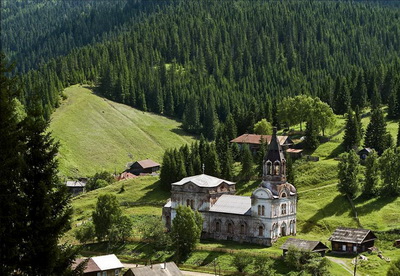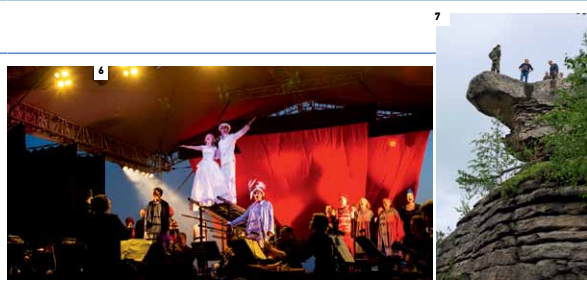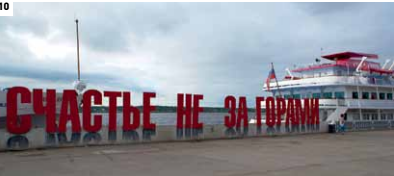The Capitals of Perm Region: Solikamsk, Gubakha, Cherdyn, Kungur

{module Ads Elite (xx)}
Ancient churches, theater festivals, hot air balloons and ice caves make up the amazing scenery of the Perm Cis-Urals.
The Perm Region is rich both in natural resources as well as gifted and savvy people. That is why each local town is sure to be on top in some field, be that salt making, black coal mining, tea trading or growing a one-of-a-kind botanical garden, particularly striking in this area. Dwellers of the Perm Region have always competed with neighboring cities: Ekaterinburg, Izhevsk and Ufa. The “specialness” of their personality is manifested in everything: in the appearance of streets and houses, in the attitude of the locals to their history, and even in the people’s disposition. That is why each town in the Perm Region differs from the others to a large extent, and that is why your journey will inevitably turn into a blast of impressions, events and encounters.
the trinity Cathedral in Solikamsk was erected in the 17th century. the icon of St. nicholas the Wonderworker, a gift from the tsar ivan the terrible, remained its principle relic for a long time. During World War ii, the Cathedral hosted exhibits evacuated from the russian museum and the Pushkin museum of Fine arts.
Solikamsk: The City of Salt

When you are strolling along the streets of solikamsk, you get the feeling that you are in one of the golden ring cities, as Solikamsk is dotted with ancient sights worthy of the Unesco world heritage listing. the city earned its prosperity from salt and copper mining and trading. in the past, solikamsk was considered the main “salt mill” for the whole of russia. local merchants spared no expense in beautifying the city. due to their largess, solikamsk gained splendid cathedrals: the church of John the forerunner sponsored by the surovtsevs family, the st. michael maleinos church patronized by the turchaninovs, the church of transfiguration supported by the shchepotkins. ordinary city dwellers were just as zealous; many churches were built with their donations, including the elegant trinity cathedral, festive epiphany cathedral, and intricately embellished cathedral of the exaltation of the holy cross, all of them located in the very center of the solikamsk.
Gubakha. Tale of Coal

The history of this small town is associated with the mount krestovaya. in the 18th century, iron ore deposits were discovered here, and people who came to mine the ore founded the town of gubakha. some time later, immense coal deposits were also detected here, and then dozens of mining pits were started all over gubakha and its outskirts. this is where the russian industrial black coal mining began. for almost two centuries, local mines supplied the whole Ural region with coal. today, when gubakha’s coal fame became history, krestovaya continues to be the town’s main landmark. every year, its slopes turn into a stage for a theater festival. thousands of visitors come here to watch outdoor musicals and ballets performed in the surrounding of wild rocks.
Perm. A Treasure Box

Though perm cannot boast many architectural masterpieces, this city offers real cultural treasures. The Diaghilev’s Seasons, and Arabesque festivals hosted by the perm opera and ballet theatre present an array of new opera and ballet productions, putting in the limelight young talented dancers and singers. even theater aficionados from moscow and st. petersburg come to perm to see spectacular productions of the perm academic theatre-theatre. exhibitions displayed at the permm museum of contemporary art transform and electrify the russian cultural life. a collection of wooden church sculptures exhibited at the perm state art gallery is the one of a kind in the world. while multimedia projects of the perm ancient history museum can compete with hollywood’s dino-blockbusters.
Cherdyn. Lost in Reverie
Amid the woods and fields, tucked away from the rest of the world by miles of bumpy roads, the town of cherdyn is a place where time has frozen. strolling along the empty streets, you will observe how traces of different epochs contribute to the overall bizarre town scenery. at some point, cherdyn served as the capital of great perm and traded with volga bulgaria and novgorod. the only reminder of that legendary period is the ruined rampart, which in the past surrounded the wooden fortress. cherdyn is renowned as boyar michael romanov’s (the uncle of the first tsar from the romanov dynasty) and poet osip mandelstam’s place of exile. the fetters displayed at the local history museum remind of the tragic destiny of the 16th-century nobleman. and a memorial plate on the wall of the house where the poet lived tells about his hardships.
Kungur. Earth and Sky

Well-maintained streets and monuments, good quality roads – that is what sets kungur apart from a typical russian provincial town. kungur became world-renowned for its major tourist attraction – a unique ice cave, but there is more than fantastic underground scenery to see in the town. kungur, once the capital of tea trading, leather-making and an administrative center managing local plants, features many landmarks from those times: gostiny dvor shopping arcade, merchants’ warehouses, mansions and churches. in the summer, a score of hot air balloons soar above the spectacular natural and manmade scenery. every year, kungur hosts the Sky Fair of the Urals festival. the tradition started back in 1995 with just one hot air balloon, purchased to entertain local residents, but over time it turned into a full-fledged hot air balloon show – an event many pilots and tourists from all over the world are looking forward to attend.
1. the Ust-Borovsk saltworks was in operation for almost a century. today, it is the museum of the History of Salt where you can observe the process of mining and refining of this product
2. visitors of the museum of salt are presented with a souvenir – a saline crystal, whose color is defined by the presence of impurities
3. till this day, Lyudmilinskaya Bore- well, located in a suburb of Solikamsk, produces brine rich in minerals and potassium. Bathing in its waters can successfully substitute costly spa treatments, the locals believe
4. in the center of Solikamsk, you will find the Governor’s House, the city’s oldest building erected in 1688. the interior of one of its rooms is a recon- struction of an ancient russian pub- lic office
5. in 1731, Grigory Demidov founded in Solikamsk the first botanical gar- den in russia, whose collection in- cluded plants brought from all over the globe. in the 19th century, the Gar- den ceased to exist, but in 2001 it was reestablished
6. For four years running, the mount Krestovaya has hosted a theater festival, and each time it turned into an unforgettable event. again and again, both the actors and spectators find out that any performance staged against the backdrop of the rocky landscape here feels like a premiere
7. in a close proximity to Gubakha, there is a natural monument known as the ‘Stone town.’ it features a score of beautiful canyons, labyrinths and caves eroded in the giant rocks by the streams of an ancient river
8, 9. once Gubakha and areas surrounding it were the land of mine workers. today, only abandoned coalmines and a unique KUB museum (the museum of Kizelovsky Coal Field) remind of the great labor achievements. the museum exhibits are dedicated exclusively to the process of coal mining: coal formation, mining and use. the exhibition includes many artifacts illustrating the nature of coal and mining methods
10. residents of Perm know one sim- ple thing – happiness does not need to be traveled to; it is in your homeland and comes from your own actions
11. the Perm ancient History museum is equipped with modern facilities. it primarily targets the young audi- ence. visitors enjoy interactive games, contests and visual effects
12. a wooden sculpture of St. nich- olas of mozhaysk, dating back to the beginning of the 19th century, is the most vivid example of this unique art style presented in the collection of the Perm State art Gallery
13. the Church of the Dormition of the Holy mother of God in Cherdyn was closed for many years. in 2000, the building was handed to the museum of History of Faith. During the restoration works, magnificent wall paintings were discovered under several layers of overpaint. the paintings depict episodes of the Last Judgement
14. though Perm zoomorphic style is not known as widely, as famous Scythian art, in which objects are made with a similar technique, it is no less expressive. the collection of these rare artifacts in Cherdyn’s local History museum is something worth seeing
15. Located not far from Kungur, Belogorsky monastery is rightfully called the Ural’s athos. the splendid Cathedral of the exaltation of the Holy Cross was built to the design of the St. vladimir Cathedral in Kiev and can accommodate up to 8,000 worshipers
16. the major tourist sight in Kungur is the ice Cave, located in the town’s 14. though Perm zoomorphic style is not known as widely, as famous Scythian art, in which objects are made with a similar technique, it is no less expressive. the collection of these rare artifacts in Cherdyn’s local History museum is something worth seeing vicinity. Wintertime is when the underground palace looks its best, embellished with ice and snow. But its ice dripstones, crystals and icefalls look no less impressive in summer
17. even if you are not a ballooner, you can still take part in the Sky Fair of the Urals festival. all you need to do is just register as an independent referee and pay the established fee
18. among the exhibits of the museum of merchant History, there are items associated with the history of the Great Siberian Way, tea trading and everyday life of Kungur’s merchants.
{ (travel)}
